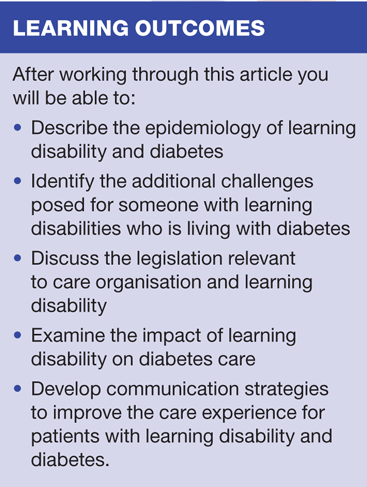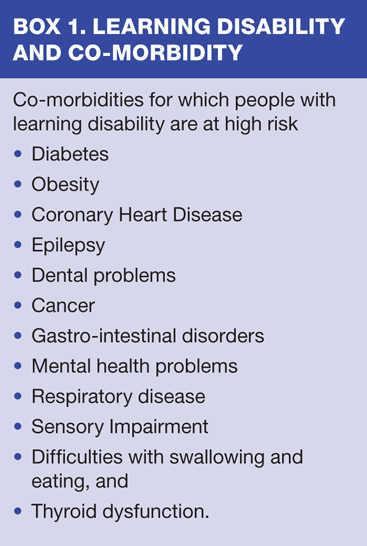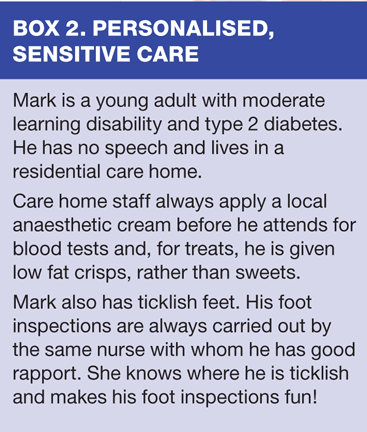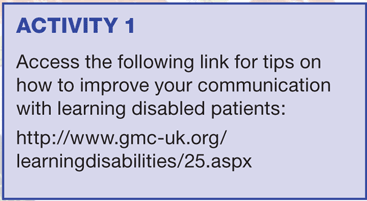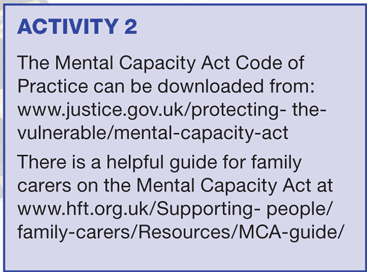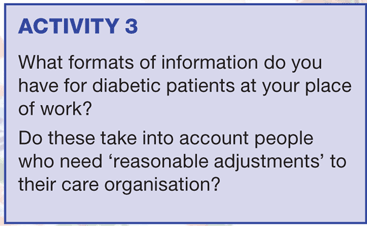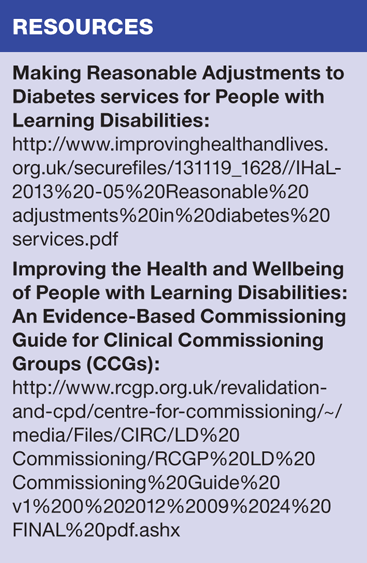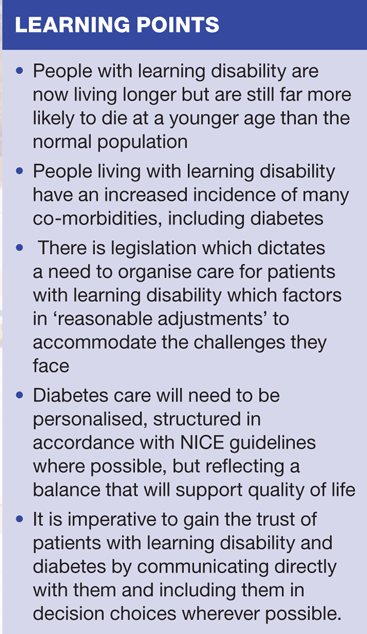Learning disability and diabetes: addressing the challenges
Rhian Last
Rhian Last
RGN MAMS PGC (Leadership) UCPPD (Quality Improvement Skills Facilitation) PGC (Primary Care Education)
Clinical Lead for Managing Long Term Conditions and Leadership, Education For Health. Member of NICE Quality Standards Advisory Committee (QSAC3)
Member of the RCGP Yorkshire Faculty Board (Nurse Educator)
People with learning disabilities are more likely to have diabetes than the general population, and those who develop diabetes require care that is sensitively organised to support their special needs
Learning disability is one of the most common forms of disability and there are approximately 1.5 million people in England affected with some form of it.1 It spans a broad spectrum which can include, for example, someone with autistic spectrum disorder, who may have significant social difficulties and yet be able to live independently and care for themselves, through to someone with profound problems who needs constant care from family members or carers, either within their own home or in an institutional setting.
In comparison with the general population people with learning disability have a shorter life expectancy. While life expectancy has increased in recent years, the mortality of people with moderate to severe learning disabilities remains three times higher than in the general population.2 People with learning disabilities have a high risk of a large number of other morbidities.3 (Box 1) They also have a higher risk of developing dementia compared with the general population. This risk is significantly greater for people with Down's syndrome and will manifest at a much earlier age.4,5
The diverse nature of learning disability will affect and impact on the care that each individual might require.6 Personalised care is essential if high quality care is to be delivered. This article will focus on the needs of learning disabled individuals with co-morbid diabetes, but many of the messages will be relevant to the other co-morbidities that these people are prone to.
DIABETES AND LEARNING DISABILITY
Both Type 1 and Type 2 diabetes are more common in learning disabled people than in the general population. A Dutch, population based study reported an increased rate of diabetes in adults with learning disabilities.7 Data recently sourced from General Practice information systems in England support this finding, demonstrating higher rates of Type 1 and Type 2 diabetes in people with learning disabilities.8
CARE ORGANISATION
Living with diabetes can pose additional challenges for people with learning disabilities. Thoughtful organisation of care and management can make a positive difference to both the patient and carer experience.
There is a legal requirement under the Equality Act 2010 and the NHS and Social Care Act 2008 to anticipate and make 'reasonable adjustments' to services for people with learning disabilities. This means moving beyond offering standard care. It necessitates a degree of flexibility and the use of different approaches to suit the individual, i.e. a personalised approach to care organisation.
Continuity of care, where this is possible, can add huge value to the patient experience. It is very important that strong bonds are formed with the patient and their families and carers. We can then learn about likes, dislikes and fears, and apply this information usefully to improve their experience. For example, a patient with autistic spectrum disorder may be extremely reluctant to attend for review during a busy surgery and would perhaps value the opportunity to attend at the end of a surgery session when everything is much quieter, and when they will not be expected to sit and wait. This might also be the case for the family or carer of a patient with severe learning disability who may present with challenging behaviour. It can be extremely distressing for them to have their loved one appear publicly disruptive. A thoughtfully timed and arranged appointment can make a huge, positive difference to their experience. For patients who are extremely challenged by their learning disability we need to explore wider opportunities for undertaking a review, for example in their own home.
When referring the patient to external services, such as annual retinal screening, it can be useful to share information, with the patient and their family or carer's consent, about any fears or worries or things that might distress them, such as crowded waiting areas, or noisy environments. Tailoring a standard referral letter in this way can set off a process that will facilitate smooth running of the service for all concerned.
INCLUSION
Taking the time and trouble to build up good rapport and a bond of trust with your patient can reap huge dividends. Never underestimate the power of a warm, welcoming smile. Be sure to speak to the patient directly, even if they don't seem able to speak back, and even when it may be their family member or carer who is conversing with you. This will demonstrate to your patient, and indirectly to their family or carer, that you see them and respect them as a person.
Some patients will present with challenging, disruptive behaviour and it's important to bear in mind that this may be born out of fear, or from not understanding what is happening. Sometimes such behaviour may stem from being in pain but being unable to express this directly. Take the time to find a different way of communicating with this person, maintaining good eye contact and perhaps using their signs or sounds. Once a person feels they are being acknowledged they will be more likely to trust you and less likely to display disruptive behaviour.
When a physical examination is indicated (such as a foot pulses check) it must not be avoided or discounted because of difficulties in communication or assessing capacity. Try to gain the patient's trust and consent to an examination. In this particular instance, it might be useful to carry out a foot pulses check on the carer first, with a calm, positive flow of conversation and explanation. This will help to demonstrate that there is nothing to be afraid of.
Blood sampling can be particularly traumatic if the person with learning disabilities does not understand what is happening and why it is important. Take the time to explain simply, using pictures where these might add clarification and value to the explanation. It is very often the fear of the unknown that is the biggest problem.
The General Medical Council has produced a comprehensive and useful guide to communicating with learning disabled people. (See Activity 1)
CONSENT AND CAPACITY
Consent must always be sought prior to any investigation or treatment. The Mental Capacity Act 2005 sets out the law regarding capacity and consent, and this is underpinned by five key principles that must be considered when assessing capacity:
1. 'A person must be assumed to have capacity unless it has been clearly established that they lack capacity regarding the specific decision under consideration at that point in time'
2. 'A person is not to be treated as unable to make a decision unless all practicable steps to help him or her to do so have been taken without success'
3. 'A person is not to be treated as unable to make a decision merely because he or she makes what is considered to be an unwise decision'
4. 'An act done, or decision made, under the Mental Capacity Act for or on behalf of a person who lacks capacity must be done, or made, in his or her best interests'
5. 'Before the act is done, or the decision is made, regard must be had to whether the purpose for which it is needed can be as effectively achieved in a way that is less restrictive of the person's rights and freedom of action.'
EARLY IDENTIFICATION
Every person with learning disabilities is entitled to an annual health check. This provides a valuable opportunity to identify wider health problems, which might otherwise only come to light when the condition becomes serious. Even at this point an illness can sometimes be missed, resulting in a premature death that might have been preventable.
This is particularly relevant for diabetes. Timely diagnosis and treatment can reduce the development of long-term complications. Consequently, being especially alert for signs and symptoms, and screening those at risk, is vital. Signs of diabetes might include persistent or recurrent infections such as mouth ulcers, candida and urinary tract infections. Symptoms might include increased thirst, increased frequency of micturition (especially at night and which may lead to nocturnal enuresis), genital itching, extreme tiredness and unexplained weight loss.
An added impediment to the early identification of diabetes in people with learning difficulties, in keeping with other undiagnosed conditions, is that signs and symptoms may be misunderstood or misinterpreted. This is referred to as 'diagnostic overshadowing'.9 Health care professionals might assume that certain behaviours are a result of the learning disability rather than an expression of symptoms. This can be further compounded if a family member or carer is dismissive of reported symptoms and the healthcare professional pays closer attention to them than to the patient. For example, if an individual has a history of demanding frequent drinks any increase in these demands may be 'brushed off' as a behaviour trait, and the possibility of diabetes not considered. It is imperative, therefore, to undertake appropriate diagnostic tests to ensure that nothing is dismissed or overlooked.
PATIENT EDUCATION
When people are newly diagnosed with diabetes there is much for them to learn and it is important to gain an understanding of any preconceptions patients may have which could affect their attitude and approach to their condition. This is no less relevant for people with learning disabilities and their families and carers. However, the information that is available to educate patients and share with them can, very often, be limited or presented in formats that are not particularly informative or helpful.
While information can be shared with family members and carers it is also essential to engage with and include the patient. Their views and feelings are intrinsic to their management plan. Sources of information to help engagement with people with learning disability are continually improving, with, for example, formats in pictures and simple language.
AIMS OF DIABETES CARE
Diabetes care needs to be personalised and in accordance with NICE guidelines: when setting a target HbA1c, involve the person (wherever possible) in decisions about their individual target level, which may be above that for people with diabetes in general. Safety is paramount and it is very important to set goals that are realistic. They should reflect a balance with patient quality of life, avoid symptomatic hyperglycaemia, and aim for the best level of glycaemic control whilst preventing hypoglycaemia.
It is of paramount importance that the family members or carers and, where appropriate, the patient themselves are able to recognise the symptoms of a hypoglycaemic attack. They need always to be ready and prepared to treat an attack with a source of glucose suitable for the individual person.
It is also essential that there is an understanding of the relational impact of any co-morbidities, for example, if the person also has epilepsy. Some seizures can mimic the classic signs of hypoglycaemia, and pronounced seizures can also suddenly drain glucose levels and precipitate a hypoglycaemic attack. Families and carers and, where possible, the patient themselves, all need to be aware of this. Identity bracelets with all the relevant information can also give peace of mind for any situations where the person may be away from those who know them and their circumstances well.
RESTRICTIONS AND LIMITATIONS
People with learning disabilities will face restrictions and limitations in their daily living and these will vary from person to person. Some factors to consider are:
- The nature and extent of the person's disability including any mobility issues
- Their activities of daily living
- Their home circumstances and any social support
- Current medications and any difficulties/compliance issues
- Their diet, including any limitations/difficulties
When facing life with severe limiting factors then what gives us pleasure will also be limited but of extreme importance. Relatives and friends who want to help will very often turn to the 'treats' of sweets and cakes and so forth as gifts. Banning all dietary 'treats' would be miserable for someone with limited sources of pleasure and it is important to strike a balance between pleasure and good diabetes control. It can be helpful to discuss with the patient and their family and carers what other things might also bring pleasure. For example, they may have a special love of cuddly toys, or picture books. Relatives need to understand that sweets are not ideal as presents, but if you can also offer alternative gift ideas this can give them a means of modifying their behaviour that will facilitate health improvement.
Adolescents and young adults with learning disabilities who have a degree of independence for socialising will face typical peer pressures, for example, with regard to smoking and alcohol, and will need appropriate advice and support.
FAMILY AND CARERS
Caring for a person with learning disabilities can be extremely hard, and also isolating. It would be prudent to affirm that their health and welfare is important too, and to remind them that as a carer they are entitled to a health check themselves.
CONCLUSION
More people with learning disability are living longer and the incidence of co-morbidity, including diabetes, in this group is rising. It is therefore important to be proactive in identifying signs and symptoms in these individuals that might indicate the need for diagnostic testing. Those who develop diabetes will require care that is sensitively organised to support their special needs. Box 2 provides a 'real-life' example of such care. Good communication is essential to form a bond of trust that facilitates patient inclusion and involvement, and legislation is already in place to drive this forward.
REFERENCES
1. Emerson E, Hatton C. People with learning disabilities in England . Centre for Disability Research (CeDR), Lancaster University. 2008 http://www.lancaster.ac.uk/cedr/publications/CeDR%202008-1%20People%20with%20Learning%20Disabilities%20in%20England.pdf
2. Tyrer F, McGrother C. Cause-specific mortality and death certificate reporting in adults with moderate to profound intellectual disabilities. Journal of Intellectual Disability Research 2009; 53: 898-904.
3. Straetmans JMJAA, van Schrojenstein Lantman-de Valk HMJ, Schellevis FG, Dinant G-J. Health problems of people with intellectual disabilities: the impact for general practice. British Journal of General Practice 2007;57:64—66.
4. Royal College of Nursing. Meeting the Health Needs of People with Learning Disabilities. RCN Guidance for Nursing Staff. Royal College of Nursing, London. 2013 http://www.rcn.org.uk/__data/assets/pdf_file/0004/78691/003024.pdf
5. Cooper SA. Epidemiology of psychiatric disorders in elderly compared with younger adults with learning disabilities. British Journal of Psychiatry 1997; 170: 375—380
6. Royal College of Nursing. Mental health nursing of adults with learning disabilities. London: RCN. 2010 http://www.rcn.org.uk/__data/assets/pdf_file/0006/78765/003184.pdf
7. Strydom A, Livingston G, King M, Hassiotis A. Prevalence of dementia in intellectual disability using different diagnostic criteria. British Journal of Psychiatry. 2007; 191: 150 -1574
8. Glover G, Emerson E, Eccles R. Using local data to monitor the Health Needs of People with Learning Disabilities. Durham: Improving Health & Lives: Learning Disabilities Public Health Observatory, 2012.
9. Jones S, Howard L, Thornicroft G. 'Diagnostic overshadowing': worse physical health care for people with mental illness. Acta Psychiatrica Scandinavica 2008; 118: 169—171. doi: 10.1111/j.1600-0447.2008.01211.x
Related articles
View all Articles

